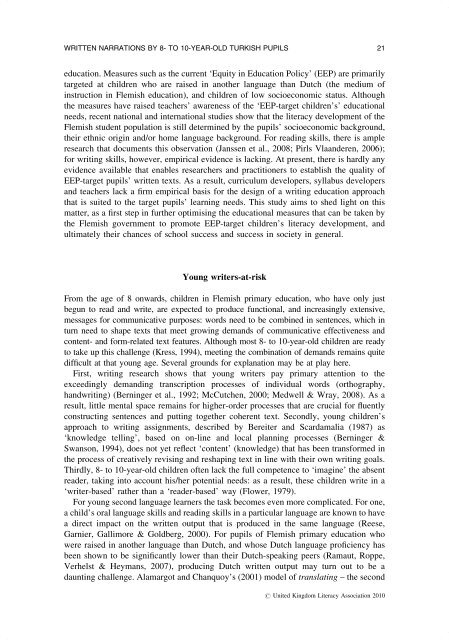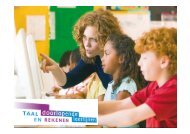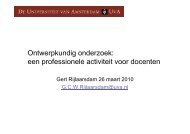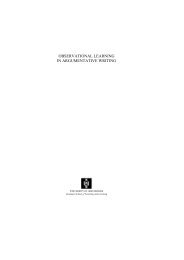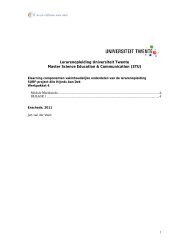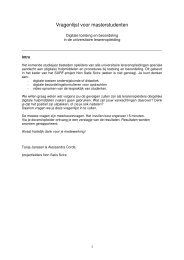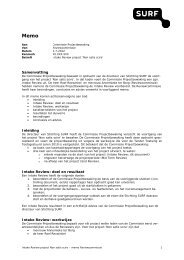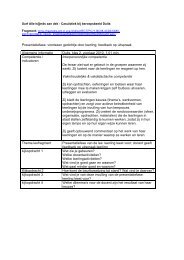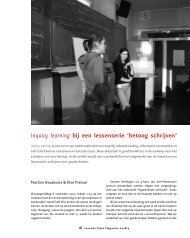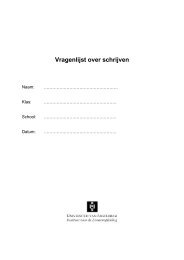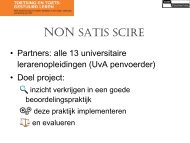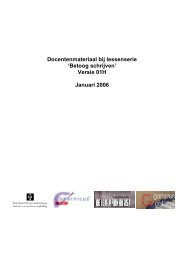to 10-year-old Turkish pupils in Flemish primary education
to 10-year-old Turkish pupils in Flemish primary education
to 10-year-old Turkish pupils in Flemish primary education
Create successful ePaper yourself
Turn your PDF publications into a flip-book with our unique Google optimized e-Paper software.
WRITTEN NARRATIONS BY 8- TO <strong>10</strong>-YEAR-OLD TURKISH PUPILS 21<br />
<strong>education</strong>. Measures such as the current ‘Equity <strong>in</strong> Education Policy’ (EEP) are primarily<br />
targeted at children who are raised <strong>in</strong> another language than Dutch (the medium of<br />
<strong>in</strong>struction <strong>in</strong> <strong>Flemish</strong> <strong>education</strong>), and children of low socioeconomic status. Although<br />
the measures have raised teachers’ awareness of the ‘EEP-target children’s’ <strong>education</strong>al<br />
needs, recent national and <strong>in</strong>ternational studies show that the literacy development of the<br />
<strong>Flemish</strong> student population is still determ<strong>in</strong>ed by the <strong>pupils</strong>’ socioeconomic background,<br />
their ethnic orig<strong>in</strong> and/or home language background. For read<strong>in</strong>g skills, there is ample<br />
research that documents this observation (Janssen et al., 2008; Pirls Vlaanderen, 2006);<br />
for writ<strong>in</strong>g skills, however, empirical evidence is lack<strong>in</strong>g. At present, there is hardly any<br />
evidence available that enables researchers and practitioners <strong>to</strong> establish the quality of<br />
EEP-target <strong>pupils</strong>’ written texts. As a result, curriculum developers, syllabus developers<br />
and teachers lack a firm empirical basis for the design of a writ<strong>in</strong>g <strong>education</strong> approach<br />
that is suited <strong>to</strong> the target <strong>pupils</strong>’ learn<strong>in</strong>g needs. This study aims <strong>to</strong> shed light on this<br />
matter, as a first step <strong>in</strong> further optimis<strong>in</strong>g the <strong>education</strong>al measures that can be taken by<br />
the <strong>Flemish</strong> government <strong>to</strong> promote EEP-target children’s literacy development, and<br />
ultimately their chances of school success and success <strong>in</strong> society <strong>in</strong> general.<br />
Young writers-at-risk<br />
From the age of 8 onwards, children <strong>in</strong> <strong>Flemish</strong> <strong>primary</strong> <strong>education</strong>, who have only just<br />
begun <strong>to</strong> read and write, are expected <strong>to</strong> produce functional, and <strong>in</strong>creas<strong>in</strong>gly extensive,<br />
messages for communicative purposes: words need <strong>to</strong> be comb<strong>in</strong>ed <strong>in</strong> sentences, which <strong>in</strong><br />
turn need <strong>to</strong> shape texts that meet grow<strong>in</strong>g demands of communicative effectiveness and<br />
content- and form-related text features. Although most 8- <strong>to</strong> <strong>10</strong>-<strong>year</strong>-<strong>old</strong> children are ready<br />
<strong>to</strong> take up this challenge (Kress, 1994), meet<strong>in</strong>g the comb<strong>in</strong>ation of demands rema<strong>in</strong>s quite<br />
difficult at that young age. Several grounds for explanation may be at play here.<br />
First, writ<strong>in</strong>g research shows that young writers pay <strong>primary</strong> attention <strong>to</strong> the<br />
exceed<strong>in</strong>gly demand<strong>in</strong>g transcription processes of <strong>in</strong>dividual words (orthography,<br />
handwrit<strong>in</strong>g) (Bern<strong>in</strong>ger et al., 1992; McCutchen, 2000; Medwell & Wray, 2008). As a<br />
result, little mental space rema<strong>in</strong>s for higher-order processes that are crucial for fluently<br />
construct<strong>in</strong>g sentences and putt<strong>in</strong>g <strong>to</strong>gether coherent text. Secondly, young children’s<br />
approach <strong>to</strong> writ<strong>in</strong>g assignments, described by Bereiter and Scardamalia (1987) as<br />
‘knowledge tell<strong>in</strong>g’, based on on-l<strong>in</strong>e and local plann<strong>in</strong>g processes (Bern<strong>in</strong>ger &<br />
Swanson, 1994), does not yet reflect ‘content’ (knowledge) that has been transformed <strong>in</strong><br />
the process of creatively revis<strong>in</strong>g and reshap<strong>in</strong>g text <strong>in</strong> l<strong>in</strong>e with their own writ<strong>in</strong>g goals.<br />
Thirdly, 8- <strong>to</strong> <strong>10</strong>-<strong>year</strong>-<strong>old</strong> children often lack the full competence <strong>to</strong> ‘imag<strong>in</strong>e’ the absent<br />
reader, tak<strong>in</strong>g <strong>in</strong><strong>to</strong> account his/her potential needs: as a result, these children write <strong>in</strong> a<br />
‘writer-based’ rather than a ‘reader-based’ way (Flower, 1979).<br />
For young second language learners the task becomes even more complicated. For one,<br />
a child’s oral language skills and read<strong>in</strong>g skills <strong>in</strong> a particular language are known <strong>to</strong> have<br />
a direct impact on the written output that is produced <strong>in</strong> the same language (Reese,<br />
Garnier, Gallimore & G<strong>old</strong>berg, 2000). For <strong>pupils</strong> of <strong>Flemish</strong> <strong>primary</strong> <strong>education</strong> who<br />
were raised <strong>in</strong> another language than Dutch, and whose Dutch language proficiency has<br />
been shown <strong>to</strong> be significantly lower than their Dutch-speak<strong>in</strong>g peers (Ramaut, Roppe,<br />
Verhelst & Heymans, 2007), produc<strong>in</strong>g Dutch written output may turn out <strong>to</strong> be a<br />
daunt<strong>in</strong>g challenge. Alamargot and Chanquoy’s (2001) model of translat<strong>in</strong>g – the second<br />
r United K<strong>in</strong>gdom Literacy Association 20<strong>10</strong>


